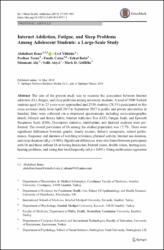| dc.contributor.author | Bener, Abdulbari | |
| dc.contributor.author | Yıldırım, Erol | |
| dc.contributor.author | Torun, Perihan | |
| dc.contributor.author | Çatan, Funda | |
| dc.contributor.author | Bolat, Erkut | |
| dc.contributor.author | Alıç, Sümmani | |
| dc.contributor.author | Akyel, Salih | |
| dc.contributor.author | Griffiths, Mark D. | |
| dc.date.accessioned | 10.07.201910:49:13 | |
| dc.date.accessioned | 2019-07-10T19:36:30Z | |
| dc.date.available | 10.07.201910:49:14 | |
| dc.date.available | 2019-07-10T19:36:30Z | |
| dc.date.issued | 2019 | en_US |
| dc.identifier.citation | Bener, A., Yıldırım, E., Torun, P., Çatan, F., Bolat, E., Alıç, S. ... Griffiths, M. (2019). Internet addiction, fatigue, and sleep problems among adolescent students: A large-scale study. International Journal of Mental Health and Addiction, 17(4), 959-969. https://dx.doi.org/10.1007/s11469-018-9937-1 | en_US |
| dc.identifier.issn | 1557-1874 | |
| dc.identifier.uri | https://hdl.handle.net/20.500.12511/1181 | |
| dc.identifier.uri | https://dx.doi.org/10.1007/s11469-018-9937-1 | |
| dc.description.abstract | The aim of the present study was to examine the association between Internet addiction (IA), fatigue, and sleep problems among university students. A total of 3000 Turkish students aged 18 to 25 years were approached and 2350 students (78.3%) participated in this cross-sectional study from April 2017 to September 2017 in public and private universities in Istanbul. Data were collected via a structured questionnaire including socio-demographic details, lifestyle and dietary habits, Internet Addiction Test (IAT), Fatigue Scale, and Epworth Sleepiness Scale (ESS). Descriptive statistics, multivariate, and factorial analyses were performed. The overall prevalence of IA among the studied population was 17.7%. There were significant differences between gender, family income, father’s occupation, school performance, frequency and duration of watching television, physical activity, Internet use duration, and sleep duration (all p <0.001). Significant differences were also found between participants with IA and those without IA in having headaches, blurred vision, double vision, hurting eyes, hearing problems, and eating fast food frequently (all p <0.001). Using multivariate regression analysis, the duration of Internet use, physical and mental symptoms, headache, hurting eyes, tired eyes, hearing problems, and ESS scores were significantly associated with (and primary predictors of) IA. The present study demonstrated that IA was associated with poor dietary habits, sleep problems, and fatigue symptoms. | en_US |
| dc.language.iso | eng | en_US |
| dc.publisher | Springer New York LLC | en_US |
| dc.rights | info:eu-repo/semantics/openAccess | en_US |
| dc.subject | Excessive Internet Ese | en_US |
| dc.subject | Fatigue | en_US |
| dc.subject | Internet Addiction | en_US |
| dc.subject | Sleep Disorders | en_US |
| dc.title | Internet addiction, fatigue, and sleep problems among adolescent students: A large-scale study | en_US |
| dc.type | article | en_US |
| dc.relation.ispartof | International Journal of Mental Health and Addiction | en_US |
| dc.department | İstanbul Medipol Üniversitesi, Uluslararası Tıp Fakültesi, Dahili Tıp Bilimleri Bölümü, Halk Sağlığı Ana Bilim Dalı | en_US |
| dc.department | İstanbul Medipol Üniversitesi, İnsan ve Toplum Bilimleri Fakültesi, Psikoloji Bölümü | en_US |
| dc.authorid | 0000-0002-7902-5803 | en_US |
| dc.authorid | 0000-0002-0575-7278 | en_US |
| dc.relation.publicationcategory | Makale - Uluslararası Hakemli Dergi - Kurum Öğretim Elemanı | en_US |
| dc.identifier.doi | 10.1007/s11469-018-9937-1 | en_US |
| dc.identifier.wosquality | Q1 | en_US |
| dc.identifier.scopusquality | Q2 | en_US |


















